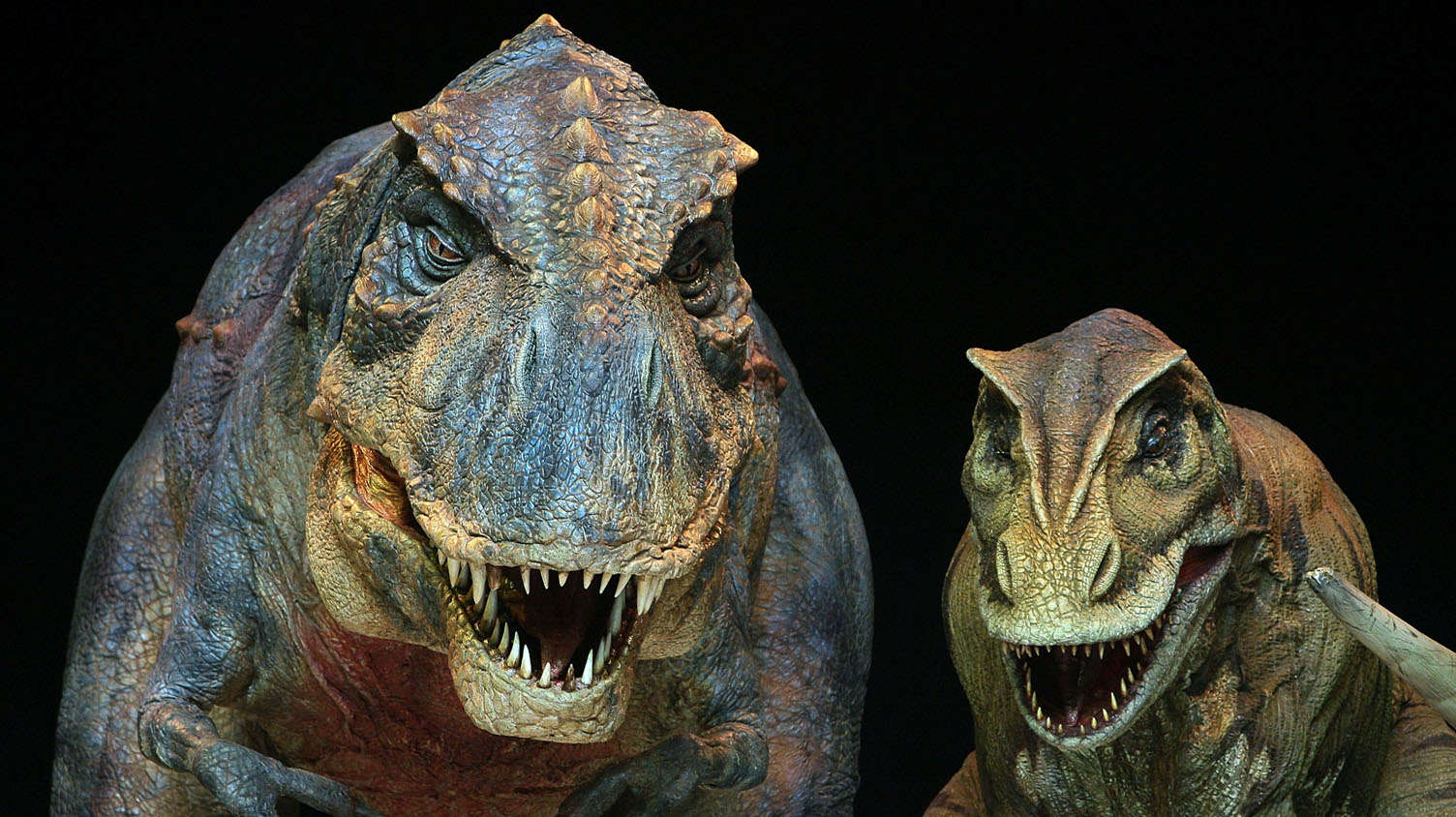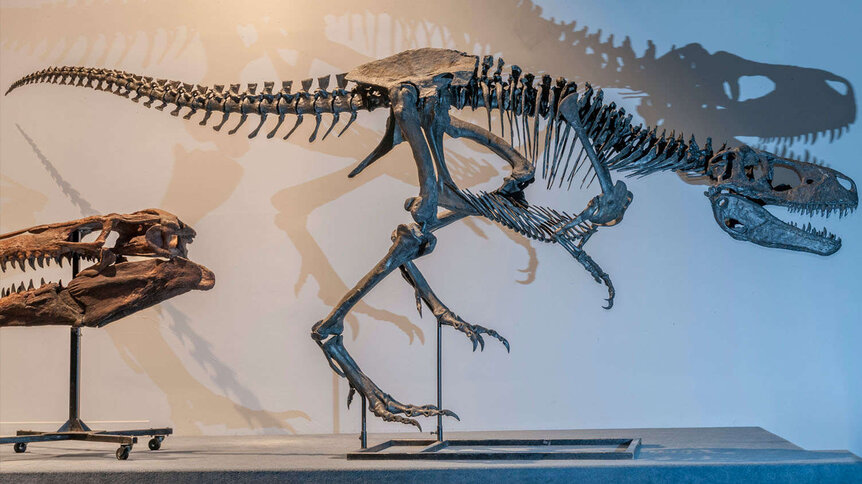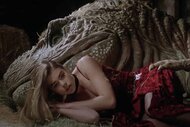Create a free profile to get unlimited access to exclusive videos, sweepstakes, and more!
Tyrannosaur mass grave could mean these monsters didn’t hunt alone

Tyrannosaurs, the bloodline of what is arguably the most famous (and infamous) dinosaur of all time—T. Rex—were voracious. Now multiply the bone-crushing power of one of these nightmares by five and imagine being the victim.
Teratophoneus, whose name translates to "monstrous murderer", may not have been the star of Jurassic Park, but this T. Rex relative was still a tyrannosaur. They were thought to be solitary hunters, and one of them was probably enough to take down a blissfully ignorant sauropod hanging out at the watering hole. Now new research is finding that they might not have been loners. The bones of several Teratophoneus that perished 76 million years ago could mean these terror lizards stalked their prey in packs.
So if tryannosaurs hunted in packs, what could that scene have looked like, besides gratuitous blood?
“The idea of tyannosaurids hunting in packs necessitates hypothesizing specialized roles among the group and not just simple 'mobbing' of prey, although I'm sure there would be intermediate steps in evolving such complex behavior,” paleontologist Alan L. Titus, who led a study recently published in PeerJ, said in an interview with SYFY WIRE. "It was actually bit overkill to do as many analyses as we did, but we were making an extraordinary claim about the tyrannosaurs dying as a group."
Monster theropods weren’t thought to play well with others. Some, like Allosaurus, even cannibalized their own kind when food was scarce. This can explain the surprise of finding the fossilized remains of at least four, possibly five Teratophoneus at the Rainbows and Unicorns Quarry (RUQ) in southern Utah, in what used to be the Laramidian land mass. Some previous discoveries of tyrannosaurids buried together had already made that assumption questionable. This find adds to the mounting evidence that they were social creatures.
The Teratophoneus fossils were first unearthed when a tyrannosaurid ankle bone was spotted in the formation, which led to the discovery of an entire pile. Ruling out the bones being buried together by coincidence meant that these huge dinosaurs needed to go under the microscope. An analysis of rare earth elements in the bones and surrounding rock would determine whether they really did die together, or whether geological processes somehow brought together a jumble of bones from the same species that only appeared like a pack.
An obstacle in this investigation was that it appeared as if the waters of a prehistoric river had washed the bones away from their original resting place and then reburied them somewhere else. Though some things had been lost to time, the chemistry of the site could reveal whether they had died together or were just thrown together by the river. Analyzing the amounts of certain carbon and oxygen isotopes and rare earth elements proved that they all came from the same region. Whether or not they really were a pack, they seemed to be.
Analyzing stable oxygen and calcium carbonate isotopes showed that the fossils, even though they were not buried where the dinosaurs originally met their end, were still part of one deposit. The same isotopes connected them fossils from other creatures that once lived in the same lake. Rare earth elements were an asset to Titus, becuase these types of elements are hypersensitive to the surrounding environment when buried with bones that are just starting to fossilize and have stil not lost all teeth or organic tissues.
"The rare earth elements showed that not only did they undergo the same early fossilization process together, but that that event had occurred in a fine-grained clay rich mud and not a river channel," he said. "Together with the hydraulic data we collected, it showed they were all buried together in a lake in very close proximity and that they all shared a collective history prior to being exhumed and reburied."
So if five Teratophoneus were felled by some unknown force, what could have done away with them? There were several possibilities that had to be checked out before Titus’ team could agree on a hypothesis. They could have been stuck in mire, but that usually leaves only bones in the lower half of the body behind, and there were too many skulls and bones from the upper body. Nothing that suggested ancient quicksand was found. Poisoning is a possibility, but only if the dinosaurs were drinking at the river and were killed almost immediately by neurotoxins in cyanobacteria, and the scientists remained skeptical of that.
Bones that are piled up like those of the ill-fated Teratophoneus are often an indication of drought. This was unlikely in the part of Laramidia they once lived in, which showed a geologic history of more humid weather than areas with the bones of dinosaurian drought casualties. They may have met their end in a fire that could have even driven them to run to the same place, which could be why their bones fossilized in a heap, and there was fire in the geologic history of the formation, but it was still unlikely. What was much more common was seasonal flooding and the mudslides that came with it. The killer was probably a flood.
Why these tyrannosaurs to become gregarious creatures is still debatable. Because there is not enough information in the fossil record for Titus and his team to prove the reasons behind this behavior, they needed to speculate based on previous studies that suggested there was a chance these carnivores didn't go it alone.
"Predators like tyrannosaurs usually only become gregarious for a couple of reasons," he said. "They come together temporarily for mating, and longer-term for cooperative hunting. These two kinds of gatherings usually have very different age population structures and we think our group reflects the hunting strategy better because of its multi-generational aspect."
So many questions still echo through deep time, but chances of this being gregarious behavior are greater than ever. It is likely that Teratophoneus and other tyrannosaurs socialized like birds (which are basically highly evolved dinosaurs). That would mean that one pair of toothy jaws helped the other when they were hungry. Though larger tyrannosaurids were probably capable of sinking their teeth into a meal alone, it was much more efficient for several of them to go in for the kill at once. Several of them would also clean up a sauropod carcass.
No other large theropods have left behind evidence that they may have hunted in groups, so this is a behavior that (at least for now) is unique to tyrannosaurs, which belong to a larger group called Ceolurosauria that includes all theropods most closely related to birds, and also extant birds. The enlargment of the ceolurosaur brain relative to its body could have given it an increased thinking bandwidth that would have allowed for more complex behaviors these dinosaurs were not capable of before.
"I'm quite sure the reality of dinosaur behavior was infinitely more sophisticated and complex than we currently imagine," Titus, who plans to continue with geochemical analyses of the bones, said. "I think after our isotopic analysis is finished, there may not be much left to prove about their behavior from fossils, but at least we will have gotten everyone thinking about the possibility of social tyrannosaurs again."
Though tyrannosaurids and their celebrity king, T. Rex, were not exactly merciful when it came to their cravings for flesh, at least gregariousness among each themsleves might have revealed a different side of the monsters.















